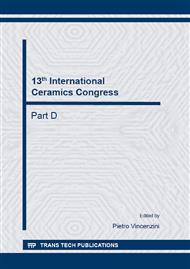[1]
T. Takenaka, H. Nagata, Y. Hiruma, Current Developments and Prospective of Lead-Free Piezoelectric Ceramics, Jap. J. Appl. Phys. 47 (2008) 3787–801.
DOI: 10.1143/jjap.47.3787
Google Scholar
[2]
J. Rödel, Wook Jo, K. Seifert, E. Anton, T. Granzow, D. Damjanovic, Perspective on the Development of Lead-free Piezoceramics, J. Am. Ceram. Soc. 92 (2009) 1153-77.
DOI: 10.1111/j.1551-2916.2009.03061.x
Google Scholar
[3]
Wook Jo, R. Dittmer, M. Acosta, J. Zang, C. Groh, E. Sapper, K. Wang, J. Rödel, Giant electric-field-induced strains in lead-free ceramics for actuator applications – status and perspective, J. Electroceramics, 29.
DOI: 10.1007/s10832-012-9742-3
Google Scholar
[1]
(2012) 71-93.
Google Scholar
[4]
S. -T. Zhang, A. B. Kounga, E. Aulbach, H. Ehrenberg, J. Rödel, Giant Strain in Lead-Free Piezoceramics Bi0. 5Na0. 5TiO3–BaTiO3–K0. 5Na0. 5NbO3 System, Appl. Phys. Lett. 91 (2007) 112906.
DOI: 10.1063/1.2783200
Google Scholar
[5]
L.A. Schmitt, J. Kling, M. Hinterstein, M. Hoelzel, Wook Jo, H. -J. Kleebe, H. Fuess, Structural investigations on lead-free Bi0. 5Na0. 5TiO3-based piezoceramics, J. Mat. Sci. 46.
DOI: 10.1007/s10853-011-5427-6
Google Scholar
[12]
(2011) 4368–4376.
Google Scholar
[6]
G. Smolenskii, V. Isupov, A. Agranivyskaya, N. Krainik, New ferroelectrics of complex composition, IV. Soviet Physics Solid State 2 (1961) 2651-4.
Google Scholar
[7]
Y. Watanabe, Y. Hiruma, H. Nagata, T. Takenaka, Phase transition temperatures and electrical properties of divalent ions (Ca2+, Sr2+ and Ba2+) substituted (Bi1/2Na1/2)TiO3 ceramics, Ceram. Int. 34 (2008) 761-64.
DOI: 10.1016/j.ceramint.2007.09.023
Google Scholar
[8]
W. Krauss, D. Schütz, F. Mautner, A. Feteira, K. Reichmann, Piezoelectric properties and phase transition temperatures of the solid solution of (1−x)(Bi0. 5Na0. 5)TiO3–xSrTiO3, J. Europ. Ceram. Soc. 30 (2010) 1827-32.
DOI: 10.1016/j.jeurceramsoc.2010.02.001
Google Scholar
[9]
Y. Hiruma, Y. Watanabe, H. Nagata, T. Takenaka, Phase transition temperatures of divalent and trivalent ions substituted (Bi1/2Na1/2)TiO3 ceramics, Key Engineering Materials 350 (2007) 93-96.
DOI: 10.1016/j.ceramint.2007.09.023
Google Scholar
[10]
R. D. Shannon, Revised effective ionic radii and systematic studies of interatomic distances in halides and chalcogenides, Acta Crystallogr. Sect. A, 32.
DOI: 10.1107/s0567739476001551
Google Scholar
[5]
(1976) 751–767.
Google Scholar
[11]
P. Jaiban, A. Rachakom, S. Jiansirisomboon, and A. Watcharapasorn, Effects of Sintering Temperatures on Preparation of BNZ Ceramic, J. Microsc. Soc. Thail. 4.
Google Scholar
[1]
(2011) 20–23.
Google Scholar
[12]
P. Jaiban, A. Rachakom, S. Jiansirisomboon, and A. Watcharapasorn, Influences of phase transition and microstructure on dielectric properties of Bi0. 5Na0. 5Zr1-xTixO3 ceramics, Nanoscale Res. Lett. 7 (2012) 45.
DOI: 10.1186/1556-276x-7-45
Google Scholar
[13]
A. Rachakom, P. Jaiban, S. Jiansirisomboon, and A. Watcharapasorn, Crystal structure and electrical properties of bismuth sodium titanate zirconate ceramics, Nanoscale Res. Lett. 7 (2012) 57.
DOI: 10.1186/1556-276x-7-57
Google Scholar
[14]
B. K. Barick, R. N. P. Choudhary, and D. K. Pradhan, Dielectric and impedance spectroscopy of zirconium modified (Na0. 5Bi0. 5)TiO3 ceramics, Ceram. Int. 39 (2013) 5695–5704.
DOI: 10.1016/j.ceramint.2012.12.087
Google Scholar
[15]
Enyew Amare Zereffa, A.V. Prasadarao, Microstructure, Phase Transition Temperature and Electrical Properties of Pure and Tin Modified (Bi0. 5Na0. 5)0. 94Ba0. 06TiO3 Lead Free Ferroelectric Ceramics, J. Basic. Appl. Sci. Res. 2 (2012) 7516-7525.
Google Scholar
[16]
J. -S. Lee, K. -N. Pham, H. -S. Han, H. -B. Lee, V. D. Ngoc Tran, Strain enhancement of lead-free Bi1/2(Na0. 82K0. 18)1/2TiO3 ceramics by Sn doping, J. Korean Phys. Soc, 60 (2012) 212-15.
DOI: 10.3938/jkps.60.212
Google Scholar
[17]
DIFFRAC plus TOPAS 3. 0, BRUKER AXS GmbH, Karlsruhe, (2006).
Google Scholar
[18]
G.O. Thomas, P.A. Thomas, Investigation of the structure and phase transitions in the novel A-site substituted distorted perovskite compound Na0. 5Bi0. 5TiO3Acta Cryst. B58 (2002) 168-178.
Google Scholar
[19]
T. Takenaka, K. Maruyama, K. Sakata, Bi1/2Na1/2TiO3–BaTiO3 System for Lead-Free Piezoelectric Ceramics, Jap. J. Appl. Phys. 30 (1991) 2236-39.
Google Scholar
[20]
T. Takenaka, H. Nagata, and Y. Hiruma, Phase Transition Temperatures and Piezoelectric Properties of (BiNa0. 5)TiO3- and (Bi0. 5K0. 5)TiO3-Based Bismuth Perovskite Lead-Free Ferroelectric Ceramics, " IEEE TUFC 56 (2009) 1595–1612.
DOI: 10.1016/j.ceramint.2007.10.023
Google Scholar


